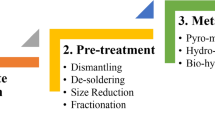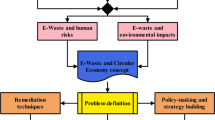Abstract
Despite international regulations that prohibit the trans-boundary movement of electronic and electric waste (e-waste), non-reusable e-waste is often illegally mixed with reusable e-waste and results in being sent to developing countries. As developing countries are not well prepared to properly manage e-waste, this illegal trade has important negative externalities and creates ‘environmental injustice’. The two main information problems on the e-waste market are imperfect monitoring and imperfect information on the so-called ‘degree of purity’ of the e-waste. In this paper, we use a simple bilateral North–South trade model and show that there exists an alternative e-waste market that is better than the standard e-waste market for developing countries. This alternative e-waste market is a joint trade in reusable and non-reusable e-waste. In both cases, we consider demand and supply sides, plus the equilibrium of the e-waste market to show that the alternative market that we propose is better for developing countries.

Similar content being viewed by others
Notes
There is no standard definition of e-waste. The term e-waste is generally used for all types of electrical and electronic equipment (EEE) that could be considered as waste. For instance, it can be TVs, computers, mobile phones, fridges, washing machines, etc.
In the 1980’s, the average disposal costs for one ton of hazardous waste in Africa was between US$2.50-$50, and in industrialized countries $100–$2000 (Kummer 1995).
Waste Electrical and Electronic Equipment (WEEE) Directives are the legislative framework within the European Union (EU) (EC regulation No. 1013/2006).
The full regulatory framework for e-waste can be found here: http://www.ilo.org/wcmsp5/groups/public/@ed_dialogue/@sector/documents/publication/wcms_196105.pdf.
For instance, it is very costly and time-consuming to check a full container of second-hand televisions to ensure that they all constitute reusable e-waste.
Note that the degree of purity of the export is different from that of the collected e-waste because of the additional e-waste D.
It is a combination of effects on both non-reusable and reusable e-waste.
References
Atasu, A., & Subramanian, R. (2012). Extended producer responsibility for e-waste: Individual or collective producer responsibility? Production and Operations Management, 21(6), 1042–1059.
Baggs, J. (2009). International trade in hazardous waste. Review of International Economics, 17, 1–16.
Bernard, S. (2015). North–south trade in reusable goods: Green design meets illegal shipments of waste. Journal of Environmental Economics and Management, 69, 22–35.
Bhutta M, Omar A, Yang X. (2011). Electronic waste: A growing concern in today’s environment. Economics Research International (serial on the Internet).
Bond, E. W. (1983). Trade in used equipment with heterogeneous firms. The Journal of Political Economy, 91(688), 705.
Clerides, S. (2008). Gains from trade in used goods: Evidence from automobiles. Journal of International Economics, 76(322), 336.
Copeland, B. R. (1991). International trade in waste products in the presence of illegal disposal. Journal of Environmental Economics and Management, 20, 143–162.
Dato P (2014) ‘Inducing sorting investment and implementation of an alternative e-waste market under imperfect information. FAERE Working Paper, 2014.13.
Favot, M. (2014). Extended producer responsibility and e-waste management: Do institutions matter? Economics And Policy Of Energy And The Environment, 56(1), 123–144.
Higashida, K. (2012) Trade in secondhand goods, monitoring of illegal trade, and import quotas on legal trade. Discussion Paper Series 90, School of Economics, Kwansei Gakuin University.
Higashida, K., & Managi, S. (2008). The determinants of trade in recyclable wastes, the structure of recycling sector and the effects of trade restrictions, mimeo.
Johnstone, N. (1998). The implications of the Basel Convention for developing countries: the case of trade in non-ferrous metal-bearing waste. Resources Conservation and Recycling, 23(1), 1–28.
Kellenberg, D. (2010). Consumer waste, backhauling, and pollution havens. Journal of Applied Economics, 13, 283–304.
Kinnaman, T., & Yokoo, H. (2011). The environmental consequences of global reuse. American Economic Review, 101, 71–76.
Kojima M., Yoshida, A., Sasaki, S., & Sungwoo, C. (2011). Trans-boundary movement of hazardous waste: Lessons from uncovered cases. In Kojima & Michida (Eds.). Economic integration and recycling in Asia: An interim report. Chosakenkyu Hokokusho: Institute of Developing Economies.
Kummer, K. (1995). International Management of Hazardous Wastes. Oxford: Clarendon Press.
Lipman, Z. (2011). Trade in hazardous waste: Environmental justice versus economic growth. Working papers, Environmental Justice and Legal Process, Macquarie University, Australia.
Sen, A. K. (1962). On the usefulness of used machines. Review of economic. and statistics, 44, 346–348.
Smith, M. A. M. (1976). International theory in Vintage Models. Review of Economic Studies, 43, 99–113.
StEP-UN. (2013). E-waste world map. Online country level data.
Tocho, J. A., & Waema, T. M. (2013). Towards an e-waste management framework in Kenya. Info, 15(5), 99–113.
UNEP. (2005). ‘E-waste, the hidden side of IT equipment’s manufacturing and use’ report. Environmental Alert Bulletin.
Author information
Authors and Affiliations
Corresponding author
Appendix
Appendix
Proof of proposition 6
The proof is divided into three cases. The first two cases are related to the alternative e-waste market, while the last case concerns the standard e-waste market.
Case 1 The reusable e-waste in the alternative e-waste market.
We use the supply X 1 = S 1(P 1) and the demand X 1 = D 1(P 1, P) of the reusable e-waste to get the following system.
-
The effect of the disposal costs and the degree of monitoring.
\(\frac{{{{d}}X_{1} }}{{{{d}}d_{N} }} = \frac{{{{d}}X_{1} }}{{{{d}}d_{S} }} = \frac{{{{d}}X_{1} }}{{{{d}}d_{N} - {{d}}d_{S} }} = \frac{{{{d}}X_{1} }}{{{{d}}\sigma }} = 0\), as X 1 is not a function of d N, d S and σ. Likewise, \(\frac{{dP_{1} }}{{dd_{N} }} = \frac{{dP_{1} }}{{dd_{S} }} = \frac{{dP_{1} }}{{dd_{N} - dd_{S} }} = \frac{{dP_{1} }}{d\sigma } = 0\), as P 1 is not a function of d N, d S and σ.
-
The effect of the resale price: (dX 1/dP and dP 1/dP).
By taking the derivative of the system with respect to P, we get:
and in matrix term:
We can then calculate the Jacobian determinant as:
From the Jacobian determinant, we can deduce:
and
Case 2 The non-reusable e-waste in the alternative e-waste market.
We also use the supply X 0 = S 0(P0) and the demand X 0 = D 0(P 0,P) of the non-reusable e-waste to get the following system.
-
The effect of the degree of monitoring and the resale price.
As neither the quantity of the non-reusable e-waste nor its price is a function of P and σ, we get no effect as follows.
-
The effect of the disposal cost dS in the South.
Taking the derivative of the system with respect to dS, we get:
In matrix form we have:
Then we deduce:
and
-
The effect of the disposal cost dN in the North.
The derivative of the system with respect to dN gives:
In matrix form we have:
We deduce that:
and
-
The effect of the difference in the disposal costs between the North and the South (d N-d S = b).
The effect on the quantity of the non-reusable e-waste is calculated as follows.
\(\frac{{dX_{0} }}{db} = \frac{{dX_{0} }}{{dd_{S} }}*\frac{{\partial d_{S} }}{\partial b} + \frac{{dX_{0} }}{{dd_{N} }}*\frac{{\partial d_{N} }}{\partial b}\) \({ = - }\frac{{dX_{0} }}{{dd_{S} }} + \frac{{dX_{0} }}{{dd_{N} }}\)
We also determine the effect on the price of the non-reusable e-waste.
\(\begin{aligned} \frac{{dP_{0} }}{db} = \frac{{dP_{0} }}{{dd_{S} }}*\frac{{\partial d_{S} }}{\partial b} + \frac{{dP_{0} }}{{dd_{N} }}*\frac{{\partial d_{N} }}{\partial b} \hfill \\ \, \hfill \\ \end{aligned}\) \(\begin{aligned} { = - }\frac{{dP_{0} }}{{dd_{S} }} + \frac{{dP_{0} }}{{dd_{N} }}\left\{ \begin{aligned} > 0{\text{ if }}\frac{{dP_{0} }}{{dd_{N} }} > \frac{{dP_{0} }}{{dd_{S} }} \hfill \\ < 0{\text{ otherwise}} \hfill \\ \end{aligned} \right. \hfill \\ \, \hfill \\ \end{aligned}\)
Case 3 The standard e-waste market.
In the case of a standard e-waste market, we consider the supply X = Se(Pe,dN,σ) and the demand X = De(Pe,P, dS,σ) of e-waste that leads to the following system.
-
The effect of the resale price P
In matrix form:
and
-
The effect of the disposal cost dN in the North.
In matrix form:
We determine:
and
-
The effect of the disposal cost dS in the South.
In the matrix form:
and the Jacobian determinant is:
We deduce that:
and
-
The effect of the difference in the disposal costs between the North and the South (dN-dS = b)
We determine the effect on the quantity of e-waste as:
The effect on the price of e-waste is:
-
The effect of the degree of the monitoring σ
The derivative of the system gives:
In matrix form:
We deduce that:
and
Rights and permissions
About this article
Cite this article
Dato, P. Economic analysis of e-waste market. Int Environ Agreements 17, 815–837 (2017). https://doi.org/10.1007/s10784-017-9350-4
Accepted:
Published:
Issue Date:
DOI: https://doi.org/10.1007/s10784-017-9350-4




